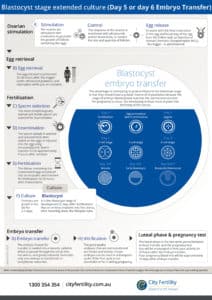Proudly part of the City Fertility Network
Proudly part of the City Fertility Network
Blastocyst embryo transfer is a specialised In Vitro Fertilisation (IVF) technique in which an embryo that has been cultured to the blastocyst stage is transferred to the womb.
It is at the blastocyst stage of development (five days after fertilisation) that an embryo would normally move out of the fallopian tube and into the uterus. Once in the uterus, the blastocyst starts to attach to the uterine lining in a process known as implantation.
The advantage of attempting to grow embryos to the blastocyst stage is that they should have a greater chance of implantation because the phase of embryo development matches the uterine environment. As a result, fewer embryos can be replaced, which will minimise the risk of a multiple pregnancy.
The disadvantage is that fewer embryos will “survive” or grow to this phase (probably about 30%-50% of them). There is a possibility (up to 10%) that none will reach the blastocyst transfer stage and therefore no embryos will be available for transfer. The availability of “extra” embryos for freezing is also significantly reduced.
Please click on the image below to view in full and download our infographic.

IVF embryos are usually transferred on the second or third day after egg retrieval, at the four to eight-cell stage. The IVF embryos must continue to grow for two or three more days to reach the blastocyst transfer stage (100-150 cells) before they are ready for implantation into the uterine wall (endometrium).
Blastocysts may have greater potential to implant into the uterine wall than earlier-stage embryos. Many embryos stop growing at the four to eight-cell stage, probably because of some inherent problem. Therefore, fewer embryos will have the ability to grow to the blastocyst stage. Those that successfully reach this stage are probably more developmentally competent than earlier-stage embryos. In addition, their stage of development, when replaced into the uterus, is very similar to what it would be in a natural conception cycle.
The potential improvement in fertility that this type of treatment may yield depends on the woman’s age, diagnosis and partner’s initial semen analysis, and should be discussed with your specialist.
Couples who have had unsuccessful attempts with IVF or IVF-ICSI despite having many good-quality eggs retrieved are being offered blastocyst culture as an alternative treatment. Couples with multiple good-quality embryos on day 3 are also strong candidates for blastocyst culture. The ability to select the most viable embryos for transfer and implantation should improve these couples’ chance of achieving a pregnancy.
In a small number of cases (less than 10%), none of the embryos develop into blastocysts and therefore no embryo transfer is performed. This might signify an inherent problem with the embryos.
To learn more, please read our fact sheet: Blastocyst culture.
Request an appointment with one of our specialists.Make your appointment